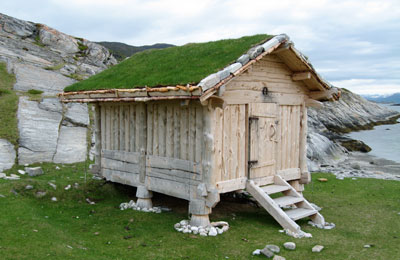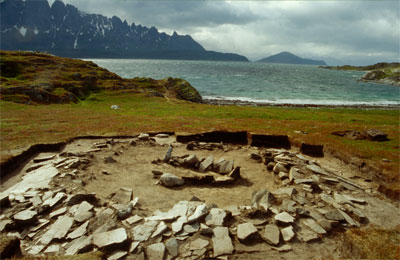Skaga
Jakt, fiske og hytteutleie
Cultural Monuments
Situated in the middle of the fiord, give the visitors to Skaga a unique view all over – specially to the spectactular Kvænangen Alps. The island itself is well fitted for hiking, numerous lakes and hills presents a fascinating landscape.  Between Dunvik and Skaga is 7-8 km long gravel road, suited for bicycling and walking. Of special interest is the large number of Sami cultural sites which tell of millenniums of human presence. In Dunvik one can see - and use - a reconstructed Sami turf hut and on the wayt outwards to Skaga many deserted farms can be seen. The cultural landscape is still kept intact through rather extensive sheep grazing and the mutton from Spildra is widely known for its quality.
Between Dunvik and Skaga is 7-8 km long gravel road, suited for bicycling and walking. Of special interest is the large number of Sami cultural sites which tell of millenniums of human presence. In Dunvik one can see - and use - a reconstructed Sami turf hut and on the wayt outwards to Skaga many deserted farms can be seen. The cultural landscape is still kept intact through rather extensive sheep grazing and the mutton from Spildra is widely known for its quality.
Spildra is well known for its cultural heritage. People have been living on the island for 8.000 years, which have resulted in quite a few important archeological findings. Most of the cultural monuments are of Sami origin, the Sami being the indigenous people of the area. Examples are sites where the Sami had their turf huts,  sacrificial sites and human graves under the rocks. The bear was a holy animal in the old Sami religion and the hunt and burial of the bear had great ritual importance. On Spildra one finds the largest number of bear graves in Scandinavia. Furthermore, there are also traces of a Viking settlement, including the remains of a huge boat house, which tells of a rather close contact between Sami and Norwegians. Most of these cultural monuments can be viewed by following a cultural trail and read a special booklet made for this purpose.
sacrificial sites and human graves under the rocks. The bear was a holy animal in the old Sami religion and the hunt and burial of the bear had great ritual importance. On Spildra one finds the largest number of bear graves in Scandinavia. Furthermore, there are also traces of a Viking settlement, including the remains of a huge boat house, which tells of a rather close contact between Sami and Norwegians. Most of these cultural monuments can be viewed by following a cultural trail and read a special booklet made for this purpose.